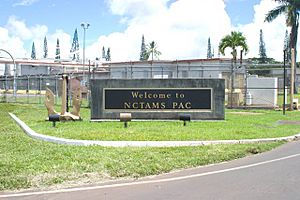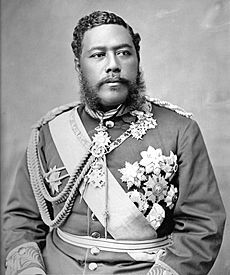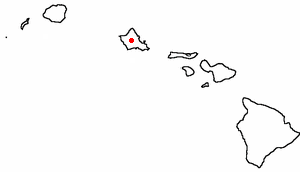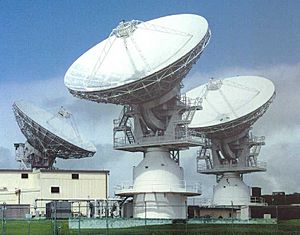Naval Computer and Telecommunications Area Master Station Pacific facts for kids
Quick facts for kids Naval Computer and Telecommunications Area Master Station Pacific |
|
|---|---|

Entrance sign at the Main Gate of NCTAMS PAC, Hawaii
|
|
| Active | 1906-present |
| Country | |
| Branch | |
| Type | Shore command |
| Role | Communications Support |
| Size | 760 |
| Nickname(s) | NCTAMS PAC |
| Decorations | Secretary of the Navy Letter of Commendation (September 1999-May 2001) |
| Commanders | |
| Commanding Officer | Captain Jaime Hill |
| Notable commanders |
RDML Lillian E. Fishburne (Ret.) |
The Naval Computer and Telecommunications Area Master Station Pacific (NCTAMS PAC) is a special United States Navy base. It is located in Wahiawa, Hawaii. This base helps manage and direct all Navy communication systems in the huge Pacific Ocean area.
NCTAMS PAC also takes care of important communication systems for the entire United States Department of Defense (DoD). It provides computer services, maintenance, and helps coordinate messages for the Navy and other DoD groups in the Pacific.
Most of the base is on the island of Oahu. It got its current name on October 20, 1997. This new name made it clearer that the base covers the whole Pacific region. In 2022, it was known as the largest telecommunications facility in the world.
Contents
History of NCTAMS PAC
Early Days: Before World War II
In May 1888, the United States set up a coaling station in Pearl Harbor, Hawaii. This station helped refuel Navy ships in the Pacific. King David Kalākaua of Hawaii had given the U.S. permission to use this area earlier that year.

The first government radio station in Hawaii started in Pearl Harbor on October 1, 1906. It operated until 1916.
On March 3, 1915, the United States Congress approved money to build a powerful, long-distance radio station. This new station, called NPM, began operating at Hospital Point, Pearl Harbor, in 1916. On September 20, 1916, it sent its first message all the way to Washington, D.C.
After World War I, Navy activities in Pearl Harbor grew a lot. It became clear that the radio station needed more space. In 1933, land at Lualualei was set aside for the Navy. Seven tall steel towers, each about 610 feet (186 meters) high, were built there for long-wave radio antennas. This new site opened in 1936, and by 1941, it had twelve transmitters working.
World War II and Moving to Wahiawa
By 1939, many United States Pacific Fleet ships were based at Pearl Harbor. This meant a new receiver and control station was needed. The Navy chose a quiet spot at Wahiawa, about 20 miles (32 km) north of Pearl Harbor. They bought the land for about one million dollars.
Construction on the 697.2-acre (2.8 km²) site began in 1940. It was planned to finish in 1942. At that time, the Wahiawa station was considered very important. It was part of a big plan to expand Naval Radio and Air Stations.
On December 7, 1941, Japanese planes flew over the Lualualei Transmitter Site. They were on their way to bomb Pearl Harbor. The main Naval Radio Stations were attacked, but few communication workers were hurt. However, the radio stations themselves were easy targets. Lualualei was close to the coast and got its power from far away. Another station, Wailupe, was also on the coast and hard to protect.
So, on December 10, it was decided to move all the equipment from Wailupe to the new Wahiawa site.
Wahiawa was an excellent place for receiving radio signals and was the best-protected radio station on the island. Workers moved everything day and night. By December 17, the move was complete, and communications continued without stopping. This location became known as the Naval Radio Station, Wahiawa. Soon after, a Security Group Unit also moved there.
In 1942, a Communications Security Unit (COMSEC) was set up at Wahiawa. It helped keep messages secret and managed message traffic. After the war, it was clear that Hawaii's naval communication facilities would remain very important.
After World War II: Growth and Changes
After the war, a committee looked at the Wahiawa facilities. They first thought the main communication point should return to Pearl Harbor. However, by 1956, there wasn't enough space in Pearl Harbor for all the communication equipment. Also, the different parts were spread out, making it hard to manage. So, it was decided to move the main communication center back to Wahiawa.
The Navy needed faster ways to send messages to its fleet commanders. In 1957, a new teletypewriter system called HICOM was started. Later, the Commander in Chief, U.S. Pacific Fleet added another fast circuit. In 1959, a new "Naval Operation Net" was created for even quicker communication.
In 1967, communication stations on Oahu were combined. Several message centers in Pearl Harbor and nearby areas came under one officer. This helped make operations more efficient.
In March 1973, a new digital message system was activated. It made sending messages faster and easier for the Pacific Fleet. In September 1977, more changes happened, and several communication centers became separate departments of the main Honolulu station.
In April 1976, the Naval Communications Station Honolulu was renamed Naval Communication Area Master Station, Eastern Pacific (NAVCAMS EASTPAC).
On February 18, 1977, NAVCAMS EASTPAC opened a new Super High Frequency (SHF) Satellite Facility at Wahiawa. It was the largest of its kind.
On December 1, 1990, NAVCAMS EASTPAC merged with another unit to form the Naval Computer and Telecommunications Area Master Station, Eastern Pacific (NCTAMS EASTPAC). This merger helped the Navy keep up with new technology.
The command changed its name again on October 20, 1997. It became the Naval Computer and Telecommunications Area Master Station, Pacific. This name better showed that it covered the entire Pacific region. Another station, NCTAMS WESTPAC, was renamed Naval Computer and Telecommunications Station Guam and now works under NCTAMS PAC.



